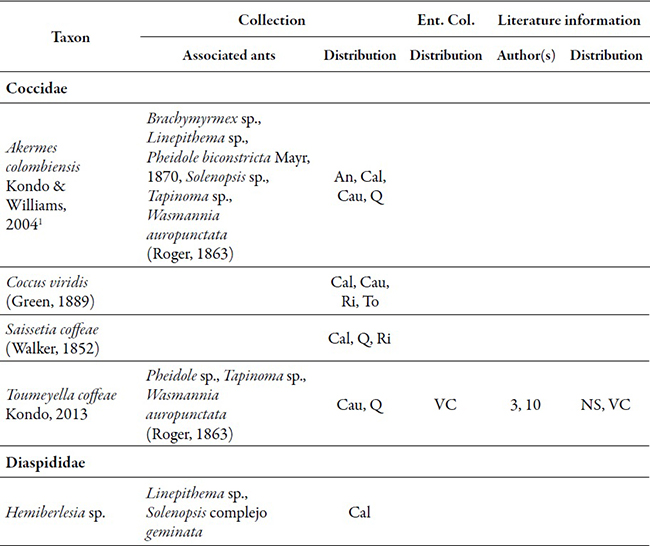Serviços Personalizados
Journal
Artigo
Indicadores
-
 Citado por SciELO
Citado por SciELO -
 Acessos
Acessos
Links relacionados
-
 Citado por Google
Citado por Google -
 Similares em
SciELO
Similares em
SciELO -
 Similares em Google
Similares em Google
Compartilhar
Ciencia y Tecnología Agropecuaria
versão impressa ISSN 0122-8706versão On-line ISSN 2500-5308
Cienc. Tecnol. Agropecuaria vol.20 no.1 Mosquera jan./abr. 2019
https://doi.org/10.21930/rcta.vol20_num1_art:1250
Sanidad vegetal y protección de cultivos
Scale insects (Hemiptera: Coccomorpha) on coffee roots (Coffea arabica L.) in Colombia, with records of associated ants (Hymenoptera: Formicidae)
1Estudiante de maestría, Universidad Nacional de Colombia, Facultad de Ciencias Agropecuarias. Bogotá D.C., Colombia.
2Investigador PhD, Instituto Colombiano Agropecuario (ICA). Bogotá D. C., Colombia.
3Investigador, Universidad Nacional de Colombia, Facultad de Ciencias Agrarias. Bogotá D.C., Colombia.
4Profesor asociado, Universidad Nacional de Colombia, Facultad de Ciencias Agrarias. Bogotá D.C., Colombia.
5Investigador científico II-Entomología, Centro Nacional de Investigaciones de Café (Cenicafe). Manizales, Colombia.
6Líder Disciplina de Entomología, Centro Nacional de Investigaciones de Café (Cenicafe). Manizales, Colombia.
Scale insects (Hemiptera: Coccomorpha) that feed on roots are considered of economic importance in crops such as coffee. Although noteworthy developments on the knowledge about the alpha taxonomy of such insects exist, more information concerning their diversity is necessary. The aim of this study was to update the list of scale insect species found on coffee roots in Colombia as well as to recognize their trophobiotic ants. Field trips were carried out in nine Colombian departments, where 541 samples were obtained. In total, 4,762 scale insect specimens and 450 ants were analyzed; Coccomorph specimens were prepared in microscopy-slides and ants were pinned in points and entomological pins. Likewise, 250 scale insect samples preserved in seven Colombian entomological collections were also examined. Lastly, scale insect records associated with coffee in Colombia were also revised based on available published literature. The current study provides a list of scale insect species on coffee in Colombia, including their geographical distribution and associated ants. The checklist of scale insects associated to coffee roots is updated to 61 species, 52 of which correspond to samples collected in the field and nine from entomological collections; 20 species were recorded for the first time in association with coffee and 15 species are new records for Colombia. Puto barberi, Geococcus coffeae, the Dysmicoccus complex texensis, Rhizoecus colombiensis and Pseudococcus elisae, were the most frequently observed scale insect species on coffee in Colombia. Furthermore, 32 morphospecies of ants were found, of which 30 are known to be in facultative trophobiotic relationships with hemipterans, and two species of the Acropyga genus are known for their trophophoresy with scale insects.
Keywords Coccoidea; hemiptera-ant association; pest insect; Neotropical region; Ortheziidae
Los insectos escama asociados a raíces son de interés económico en cultivos como el café. Aunque existen desarrollos notables en el conocimiento sobre la taxonomía alfa de tales insectos, se requiere mas información sobre su diversidad. El objetivo de este trabajo fue actualizar la lista de especies de insectos escama huéspedes en raíces de café en Colombia, así como reconocer sus hormigas trofobioticas. Se recolectaron 541 muestras en nueve departamentos de Colombia; se analizaron 4.762 especímenes de insectos escama y 450 hormigas. Los coccomorfos se prepararon en laminas para microscopia y las hormigas, en doble montaje en seco. Asimismo, se examinaron 250 muestras de escamas conservadas en siete colecciones entomológicos de Colombia. Por ultimo, se revisó la literatura relacionada con registros previos de escamas en café para el país. La presente investigación provee una lista actualizada de especies de insectos escama para el cultivo en el país, incluida su distribución geográfica y hormigas asociadas. Se actualiza la lista de insectos escama asociadas a raíces de café a 61 especies, 52 de ellas obtenidas a partir de las muestras analizadas y nueve por registros de literatura; se hacen 20 nuevos registros de asociación con café y 15 nuevos registros para Colombia. Las especies con mayor presencia en el cultivo fueron Puto barberi, Geococcus coffeae, complejo Dysmicoccus texensis, Rhizoecus colombiensis y Pseudococcus elisae. Además, se obtuvieron 32 morfoespecies de hormigas, de las cuales 30 se conocen en relaciones trofobioticas facultativas con hemípteros, y dos del género Acropyga en trofoforesia.
Palabras clave asociación hemíptero-hormiga; Coccoidea; insectos dañinos; Neotrópico; Ortheziidae
Introduction
Coffee (Rubiaceae: Coffea spp.) is one of the most marketed plant-based products worldwide and generates about 24 billion dollars for the seven million tons produced per year (Food and Agriculture Organization of the United Nations [FAO], 2015).
Coffee is the most important export crop for Colombia, with 30 % of the total planted area in the country (903,000 ha), followed by sugar cane (19 %), African palm (16 %), and cocoa (6.6 %), among others (National Administrative Department of Statistics [DANE], 2016). The economic importance of coffee and the interest to improve yields and lower production costs results in having to carry out research in multiple areas of the agronomy of this crop (Waller, Bigger, & Hillocks, 2007). In this context, insect taxonomy is one of the most active research areas in coffee farming, seeking to recognize the insect species associated with this crop (Le Pelley, 1973; Waller et al., 2007).
The term scale insects groups in a broad sense, insects belonging to the infraorder Coccomorpha, suborder Sternorrhyncha, order Hemiptera (Williams & Hodgson, 2014). They are the most diverse group of the suborder, with small sizes (< 5 mm), cryptic habits and with diverse reproductive processes; likewise, they show contrasting sexual dimorphism, reduced mobility —mainly in adult females— and the ability to secrete waxy substances that offer protection from environmental conditions and natural controllers. These insects also have trophobiotic relationships with other insects, mainly ants (Ben-Dov & Hodgson, 1997; Gavrilov & Kuznetsova, 2007; Gullan & Cranston, 2005; Gullan & Martin, 2003; Kondo & Gullan, 2010; Kondo, Ramos, & Vergara, 2008; Ramos & Serna, 2004). Nearly 8,000 scale insect species are known and have been grouped into 47 families (32 existing and 15 extinct), of which 187 species are recorded for coffee (Garcia- Morales et al., 2016). The general richness of Coccomorpha for Colombia is estimated at 244 species, grouped into 14 families, including Diaspididae (78 species), Pseudococcidae (60), Coccidae (46) and Rhizoecidae (22), among others (Ben-Dov, 1994; Ramos-Portilla, Gil, & Benavides, 2018; Garcia Morales et al., 2016; Kondo, 2001; Kondo, Rodriguez, Diaz, Dix, & Palacio, 2018).
In Colombia, 45 of these species are associated with plants of the genus Coffea Linnaeus, 1753 (Balachowsky, 1959; Beardsley, 1970; Caballero et al., 2018; Gallego & Velez, 1992; Garcia Morales et al., 2016; Granara de Willink, 2009; Hambleton, 1946, 1976, 1977; Kondo, 2001, 2013; Kondo et al., 2008; Murillo, 1931; Posada, 1989; Ramos & Serna, 2004; Ramos-Portilla & Caballero, 2016; Williams & Granara de Willink, 1992).
These insects are characterized by having an exclusive phytosuccivorous habit, which can generate direct and indirect physiological problems to the plants, such as weakening by extraction of photoassimilates, transmission of phytopathogenic microorganisms, and in severe cases, the death of the plant (Gullan & Martin, 2003). The first record of scale insects in coffee was published by Nicolas Saenz in 1893, who detected Saissetia coffeae (Walker, 1852) (Coccidae) and Pseudococcus longispinus (Targioni Tozzetti, 1867) (Pseudococcidae), but with no record of economic affectation (Bustillo, 2008). The first phytosanitary problem caused by scale insects in roots of Colombian coffee plantations was recorded in the thirties, when the population of Puto antioquensis (Murillo, 1931) (Putoidae) increased to the point of generating economic losses (Federacion Nacional de Cafeteros, 1932). Later, in the sixties and seventies, species such as Neochavesia caldasiae (Balachowsky, 1957) and Rhizoecus coffeae Laing, 1925 (Rhizoecidae) were recorded, with damage focused on the departments of Antioquia and Caldas (Benavides-Gomez & Cardenas-Murillo, 1977). Since 2008, this group regained economic importance with the increase of the mealybug populations, mainly Puto barberi (Cockerell, 1895) (Putoidae), Dysmicoccus brevipes (Cockerell, 1893) and Pseudococcus jackbeardsleyiGimpel and Miller, 1996 (Pseudococcidae) in areas of the coffee-growing area or Eje Cafetero (Gil, Benavides, & Villegas, 2015; Villegas, Benavides, Zabala, & Ramos, 2009; Villegas-Garcia & Benavides-Machado, 2011). In 2013, the first severe attack caused by the coccid Toumeyella coffeae Kondo, 2013, was recorded in roots of coffee plantations in the department of Norte de Santander (Gil & Benavides, 2017; Gil et al., 2015; Kondo, 2013).
Prior to the current study, 32 scale insect species had been recorded for Colombia in association with coffee roots: Toumeyella coffeae Kondo, 2013 (Coccidae); Mixorthezia minima Koczne Benedicty and Kozar, 2004 (Ortheziidae); Dysmicoccus brevipes, D. caribensis Granara de Willink, 2009, D. grassii (Leonardi, 1913), D. mackenziei Beardsley, 1965, D. neobrevipes Bearsdley, 1959, D. radicis (Green, 1933), D. texensis (Tinsley, 1900), D. varius Granara de Willink, 2009, Phenacoccus solani Ferris, 1918, Planococcus citri (Risso, 1813), Planococcus minor (Maskell, 1897), Pseudococcus elisae Borchsenius, 1947, Pseudococcus jackbeardsleyi Gimpel and Miller, 1996, Pseudococcus landoi (Balachowsky, 1959) (Pseudococcidae); Puto antioquensis and Puto barberi (Putoidae); Capitisetella migrans (Green, 1933), Geococcus coffeae Green, 1933, Neochavesia caldasiae, N. eversi (Beardsley, 1970), N. trinidadensis (Beardsley, 1970), Pseudorhizoecus proximus Green, 1933, Rhizoecus americanus (Hambleton, 1946), R. arabicus (Hambleton, 1976), R. coffeae, R. colombiensis Ramos and Caballero, 2016, R. compotor Williams and Granara de Willink, 1992, R. mayanus (Hambleton, 1946), R. setosus (Hambleton, 1946) and Ripersiella andensis (Hambleton, 1946) (Rhizoecidae) (Balachowsky, 1959; Benavides- Gomez & Cardenas-Murillo, 1977; Caballero et al., 2018; Granara de Willink, 2009; Hambleton, 1946, 1977; Kondo, 2001, 2013; Kondo et al., 2008; Murillo, 1931; Ramos-Portilla & Caballero, 2016; Villegas et al., 2009; Williams & Granara de Willink, 1992).
Regarding the trophobiosis association between hypogeous scale insects and ants (Hymenoptera: Formicidae), Colombia shows records of C. migrans, N. trinidadensis and Ps. proximus, attended by Acropyga goeldii Forel, 1893; D. brevipes, attended by Prionopelta sp. and Solenopsis geminata (Fabricius, 1804); D. neobrevipes and D. texensis, by S. geminata; G. coffeae, by Solenopsis sp. and Tranopelta sp.; N. caldasiae, by Acropyga fuhrmanni (Forel, 1914); P. barberi, by Acropyga exsanguis (Wheeler, 1909), S. geminata, Tranopelta gilva Mayr, 1886 and Wasmannia auropunctata (Roger, 1863); R. caladii and R. coffeae, by A. exsanguis, and R. setosus, by Acropyga sp. (Benavides-Gomez & Cardenas-Murillo, 1977; Kondo et al., 2008; Villegas et al., 2009; Williams, 1998).
It is necessary to maintain an updated inventory of the scale insect species associated with coffee crop and expand their biological and ecological information, aspects in which the trophobiosis scale insects-ants are highlighted. For this reason, the aim of this study was to know the taxonomic composition of insects of the infraorder Coccomorpha in the rhizosphere of coffee cropping and their associated ants in Colombia, in order to contribute to the elaboration of integrated management plans.
Materials and methods
Samples of scale insects and associated ants were collected manually between January 2015 and July 2017, by officials of Servicio de Extension Rural de la Federacion Nacional de Cafeteros de Colombia (FNC) and of Instituto Colombiano Agropecuario (ICA), as well as well as by the authors AC, AARP, ZNG and PB, in the Colombian departments of Antioquia, Caldas, Casanare, Cauca, Huila, Narino, Quindio, Risaralda and Santander. The plots from where the samples were taken were randomly selected based on the information included in Sistema de Informacion Cafetera (SICA) managed by Centro Nacional de Investigaciones de Cafe (Cenicafe), and also considering that farms should be under the supervision of ICA. Furthermore, plants should have less than, or up to two years of age of being planted. For ant collections, their interaction with the scale insects was verified, either because the former were stimulating the latter for the excretion of honey dew or transporting them.
In addition, scale insect specimens conserved in entomological collections of several research institutions were studied, including the following. Museo Entomologico “Universidad Nacional Agronomia Bogota” (UNAB) and the Arthropod Collection of Instituto de Ciencias Naturales (ICN) (Universidad Nacional de Colombia, sede Bogota); Museo Entomologico “Francisco Luis Gallego” (MEFLG) (Universidad Nacional de Colombia, sede Medellin); Museo de Entomologia de la Universidad Nacional - Sede Palmira (UNCP) (Universidad Nacional de Colombia, sede Palmira); Museo Entomologico Marcial Benavides (MEMB) (Cenicafe, Caldas); Coleccion Entomologica Luis Maria Murillo (CTNI) (AGROSAVIA, Cundinamarca), and entomological collection of Centro de Investigacion Palmira (MECP) (AGROSAVIA, Valle del Cauca). The list was supplemented with information gathered from scientific literature.
The collected scale insect specimens and entomological collections were preserved in 70 % alcohol and prepared in plates for microscopy, based on the modified protocol of Sirisena, Watson, Hemachandra and Wijayagunasekara (2013). The macroscopic observations were made with a Nikon MSZ-1 stereomicroscopes, and the microscopic ones with an Olympus CX31 optical microscope and Nikon Eclipse E600 and a Zeiss Axio Lab A1 phase contrast microscope. Photographs were taken and analyzed with a Lumenera 1-5C camera and the Image Pro Insight 8.0 software, respectively. The postharvest curation process was carried out mainly in the UNAB Entomological Museum and the Abraham Willink Higher Institute of Entomology of Universidad Nacional de Tucuman (Argentina).
The specimens collected are largely conserved in the Central Taxonomic Collection of the UNAB museum with backup copies in MEMB. The identification of the material was made based on the study of the external morphology of the adult female. The identification of some specimens of the genus Rhizoecus Kunckel d'Herculais, 1878, was based on the recognition of genital chambers. The following taxonomic keys and descriptions were employed: Balachowsky (1959), Cox (1978), Gill (1988), Gill, Nakahara and Williams (1977), Gimpel and Miller (1996), Granara de Willink (2009), Granara de Willink and Szumik (2007), Kondo (2013), Kondo and Williams (2004), Kosztarab (1996), Kosztarab and Kozar (1988), Kozar and Konczne-Benedicty (2007), McKenzie (1967, 1967), Miller and McKenzie (1971, 1973), Ramos-Portilla and Caballero (2016), Schneider and Lapolla (2011), von Ellenrieder and Watson (2016), Williams (2004a, 2004b), Williams and Granara by Willink (1992), Williams and Watson (1988), and Williams and Kosztarab (1972).
Ants were collected and kept in 70 % alcohol; later, they were mounted in entomological pins and their taxonomic identification was made by observing the morphology of minor and older worker ants.
The Nikon MSZ-1 stereomicroscopes was used with 10 X, 20 X and 30 X eyepieces; the diagnoses and taxonomic keys of Fernandez (2003), Jimenez, Fernandez, Arias and Lozano-Zambrano (2007), LaPolla (2004), LaPolla, Brady and Shattuck (2010), LaPolla and Fisher (2014), and Longino (2009), Longino and Fernandez (2007), Pacheco and Mackay (2013), Sarnat, Fischer, Guenard and Economo (2015), Wild (2007) and Wilson (2003) were used, as well as the comparison of specimens with cured specimens from the Central Taxonomic Collection of the Entomological Museum UNAB and digital resources such as AntWeb4, AntWiki5 and Bolton6.
Results and discussion
Coccomorpha
A total number of 4,762 specimens were analyzed from 541 samples collected, and about 250 from the entomological collections of UNAB and MEMB. The other entomological collections consulted do not conserve specimens collected in coffee roots. From all the specimens studied, 52 species of Coccomorphs were identified in seven families: Coccidae (4 spp.), Diaspididae (2 spp.), Margarodidae (1 sp.), Ortheziidae (4 spp.), Pseudococcidae (22 spp.), Putoidae (1 sp.), and Rhizoecidae (18 spp.) (table 1).
Table 1 (cont) List of Coccomorpha species and their associated ants to coffee roots in Colombia (Cont.)
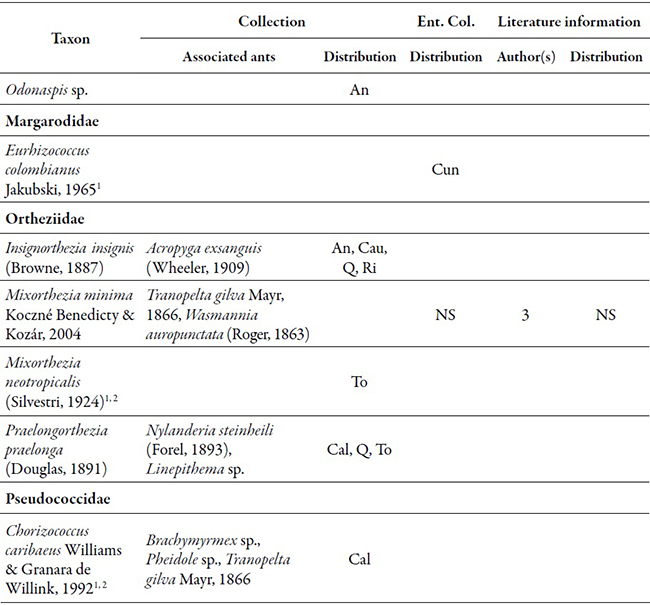
Table 1 (cont) List of Coccomorpha species and their associated ants to coffee roots in Colombia (Cont.)
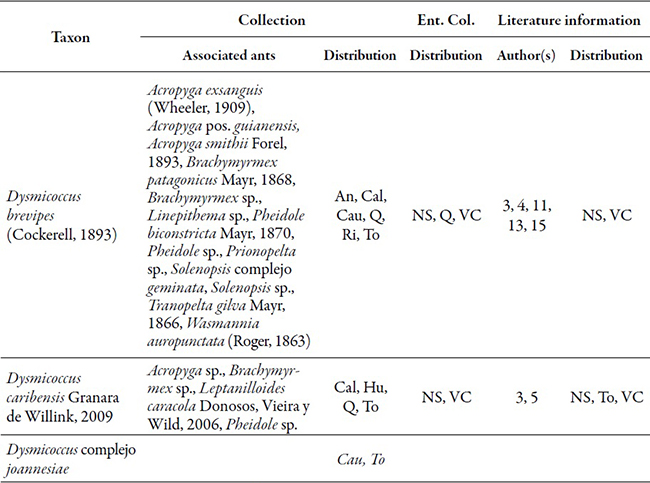
Table 1 (cont) List of Coccomorpha species and their associated ants to coffee roots in Colombia (Cont.)
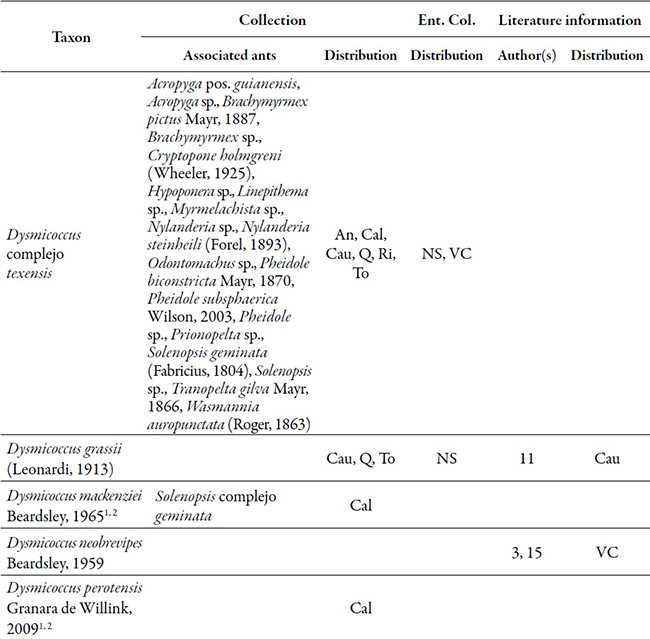
Table 1 (cont) List of Coccomorpha species and their associated ants to coffee roots in Colombia (Cont.)
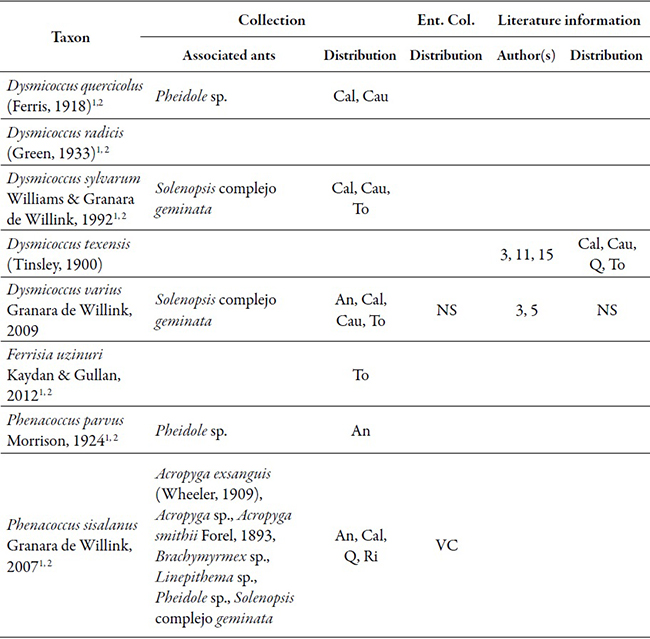
Table 1 (cont) List of Coccomorpha species and their associated ants to coffee roots in Colombia (Cont.)
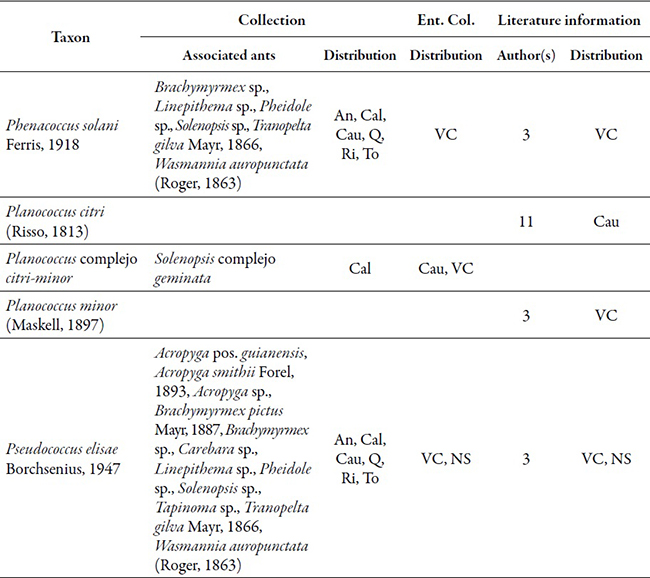
Table 1 (cont) List of Coccomorpha species and their associated ants to coffee roots in Colombia (Cont.)
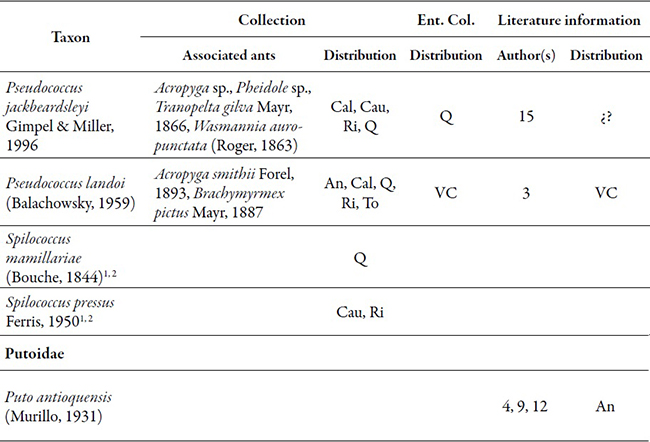
Table 1 (cont) List of Coccomorpha species and their associated ants to coffee roots in Colombia (Cont.)
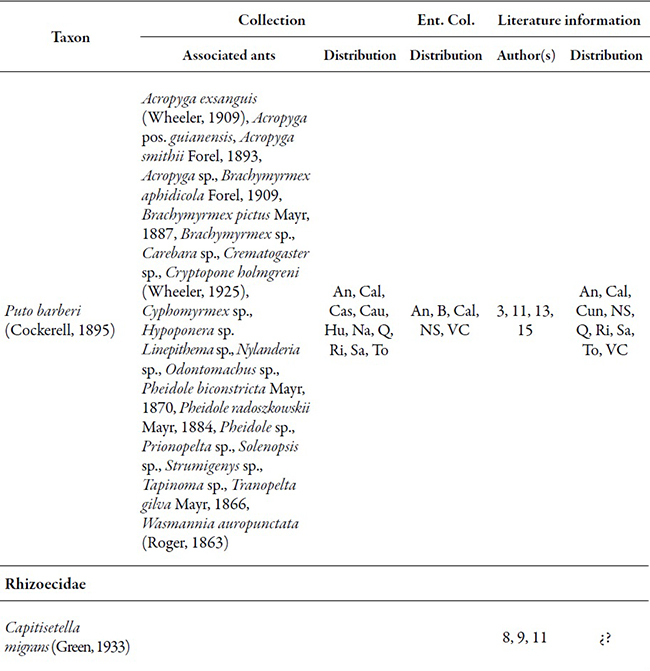
Table 1 (cont) List of Coccomorpha species and their associated ants to coffee roots in Colombia (Cont.)
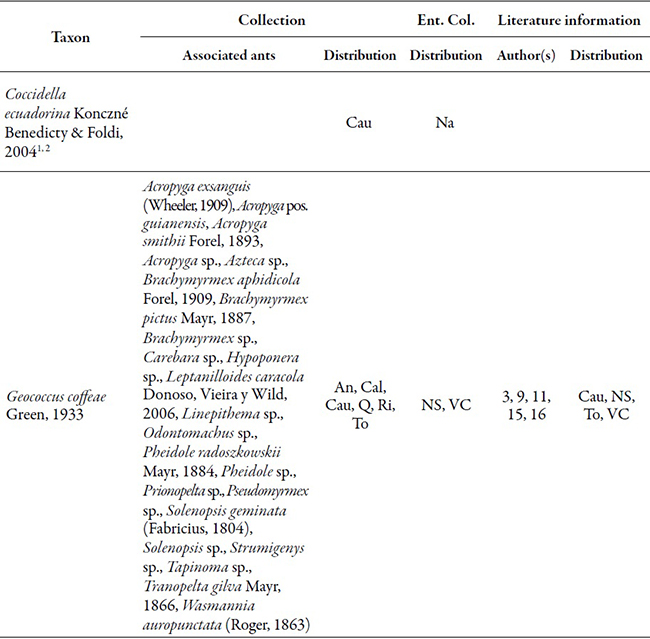
Table 1 (cont) List of Coccomorpha species and their associated ants to coffee roots in Colombia (Cont.)
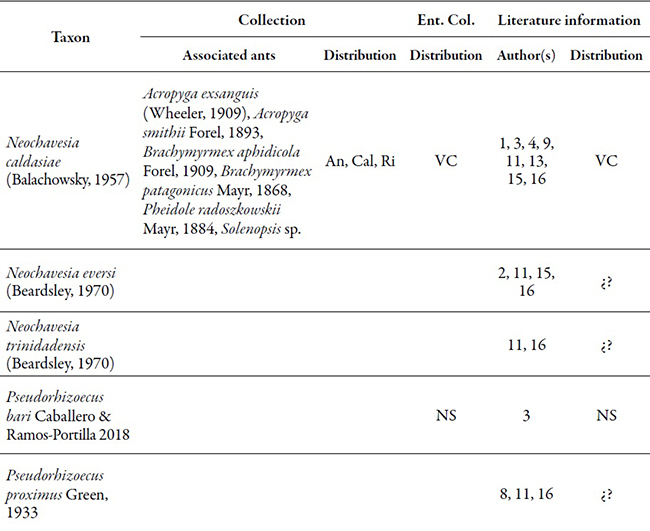
Table 1 (cont) List of Coccomorpha species and their associated ants to coffee roots in Colombia (Cont.)
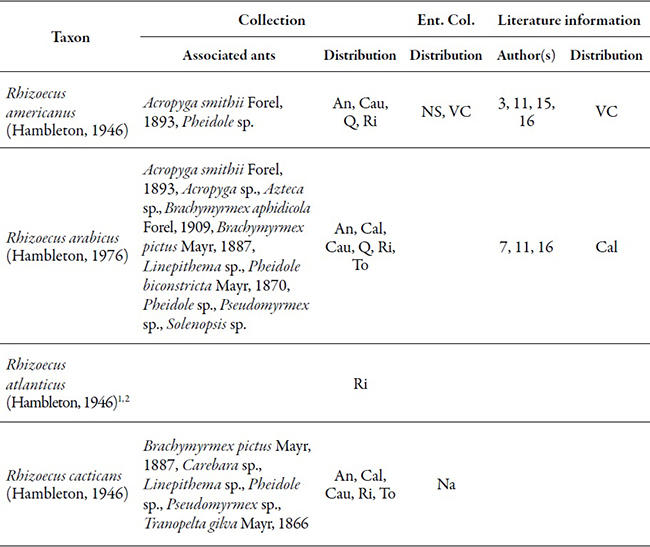
Table 1 (cont) List of Coccomorpha species and their associated ants to coffee roots in Colombia (Cont.)
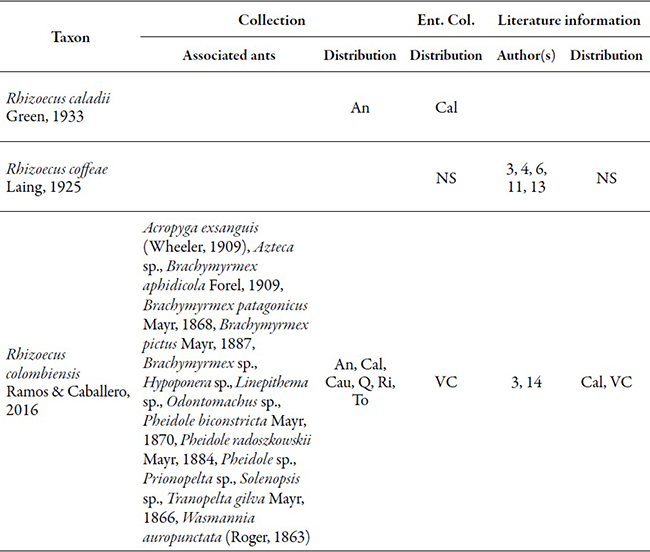
Table 1 (cont) List of Coccomorpha species and their associated ants to coffee roots in Colombia (Cont.)
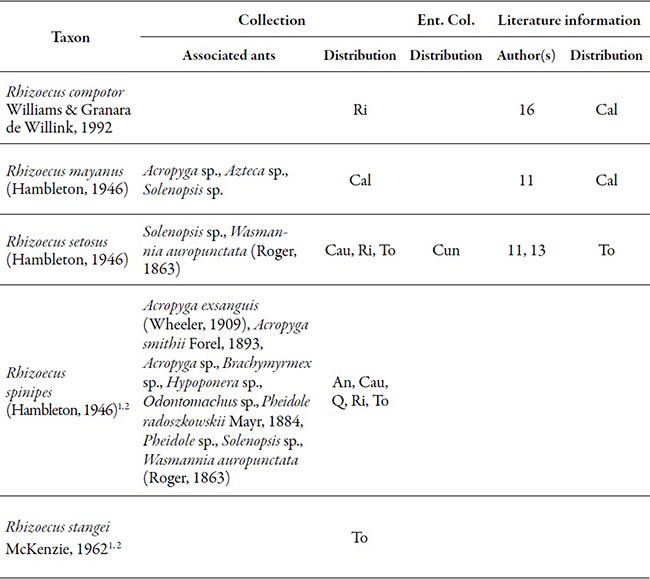
Table 1 (cont) List of Coccomorpha species and their associated ants to coffee roots in Colombia (Cont.)
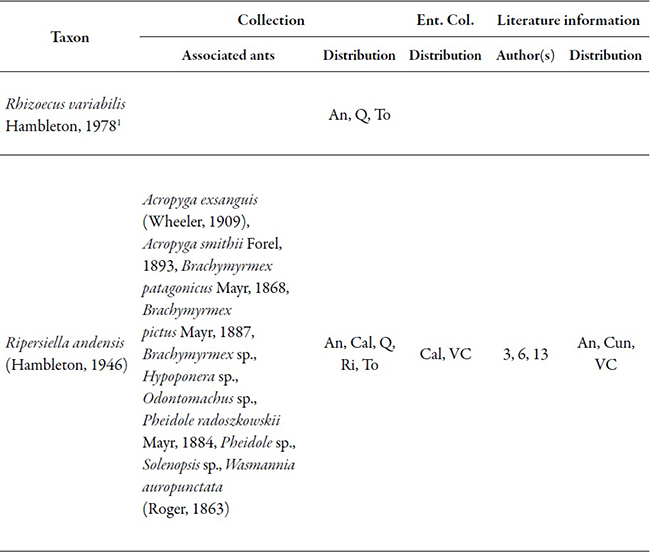
Source: Elaborated by the authors
Note: Information is presented discriminated by taxon and the source of the specimen collection (field collection, entomological collection and literature). For those specimens collected, the associated species and the distribution by departments are indicated. For the samples found in entomological collections, the departments where they were collected are shown. For the species listed from the literature, the references and geographical location indicated in the publication are cited. Abbreviations: (Ent. Col.) entomological collections; Colombian departments: (An) Antioquia, (B) Boyaca, (Cal) Caldas, (Cas) Casanare, (Cau) Cauca, (Cun) Cundinamarca, (Hu) Huila, (Na) Narino, (NS) Norte de Santander, (Q) Quindio, (Ri) Risaralda, (Sa) Santander, (To) Tolima, (VC) Valle del Cauca. Cited authors: (1) Balachowsky (1957); (2) Beardsley (1970); (3) Caballero et al. (2018); (4) Gallego & Velez (1992); (5) Granara de Willink (2009); (6) Hambleton (1946); (7) Hambleton (1976); (8) Hambleton (1977); (9) Kondo (2001); (10) Kondo (2013); (11) Kondo et al. (2008); (12) Murillo (1931); (13) Posada (1989); (14) Ramos-Portilla and Caballero (2016); (15) Villegas et al. (2009); (16) Williams and Granara de Willink (1992). Superscript 1 = New record for Coffea arabica and 2 = New record for Colombia
Akermes colombiensisKondo & Williams, 2004 (Coccidae), Eurhizococcus colombianus Jakubski, 1965 (Margarodidae), Phenacoccus solani Ferris, 1918 (Pseudococcidae) and Rhizoecus variabilis Hambleton, 1978 (Rhizoecidae) are recorded for the first time for coffee. A. colombiensis is recorded as a host in the epigeous plant stratum of the botanical families Lauraceae, Melastomataceae and Myrtaceae (Kondo & Williams, 2004); E. colombianus is a hypogeous species and is recorded on roots of plant species of the families Apiaceae, Lauraceae, Rosaceae and Vitaceae (Figueroa, 1946; Jakubski, 1965; Kondo & Gomez, 2008); P. solani is polyphagous (Ben-Dov, 1994, 2005; Chatzidimitriou et al., 2016; Kondo et al., 2008), without precise records of the plant structure that it colonizes; Rhizoecidae are recorded on Agave sp. (Asparagaceae), Musa sp. (Musaceae) and Wedelia fructicosa Jacq. 1760 (Asteraceae) (Garcia Morales et al., 2016; Kondo et al., 2008). On the other hand, Mixorthezia neotropicalis (Silvestri, 1924) (Ortheziidae), Chorizococcus caribaeus Williams & Granara by Willink, 1992, Dysmicoccus mackenziei Beardsley, 1959, D. perotensis Granara by Willink, 2009, D. quercicolus Granara by Willink, 2009, D sylvarum Williams & Granara by Willink, 1992, Ferrisia uzinuri Kaydan & Gullan, 2012, Phenacoccus parvus Morrison, 1924, P. sisalanus Granara by Willink, 2009, Spilococcus mamillariae (Bouche, 1844), S. pressus Ferris, 1950 (Pseudococcidae), Coccidella ecuadorina Konczne Benedicty & Foldi, 2004, Rhizoecus atlanticus (Hambleton, 1946), R. spinipes (Hambleton, 1946) and R. stangei McKenzie, 1962 (Rhizoecidae) are recorded for the first time in association with coffee, and their distribution has now expanded to Colombia.
Rhizoecus cacticans (Hambleton, 1946) and Rhizoecus caladii Green, 1933 were previously recorded in Colombia, associated with other hosts. Rhizoecus cacticans is recorded in Colombia and associated to Agave sp. (Asparagaceae) and Fragaria sp. (Rosaceae) (Posada, 1989; Williams & Granara de Willink, 1992); its record on coffee comes from Guatemala (Williams & Granara de Willink, 1992). Rhizoecus caladii Green, 1933, is recorded in Colombia associated with roots of Andropogon sp., and Brachiaria sp. (Poaceae), and its record on coffee comes from Surinam (Hambleton, 1976; Williams & Granara de Willink, 1992).
On the other hand, the coccids Coccus viridis (Green, 1889) and Saissetia coffeae (Walker, 1852), and the ortheziids Insignorthezia insignis (Browne, 1887) and Praelongorthezia praelonga (Douglas, 1891) have been previously recorded on coffee in Colombia, but only in the aerial parts of the plant (Ben-Dov, 1994; Kondo, 2001; Posada, 1989). This is the first record of these ortheziids on the roots of its hosts in Colombia. Further, De Lotto (1965) recorded S. coffeae associated with coffee roots in Kenya.
Regarding the family Diaspididae, specimens belonging to the genera Odonaspis (Leonardi, 1897) and Hemiberlesia (Cockerell, 1897) were found. Specimens of the genus Odonaspis are recorded exclusively associated with roots of host plants distributed in ten families (mainly Poaceae), in which Rubiaceae is not included (Aono, 2009; Ben-Dov, 1988). This is the first record of Odonaspis in association with Coffeae arabica, specifically with the Geisha variety. In contrast, Hemiberlesia is a genus of which there is no record of hypogeal habit and with the information reported in this study, knowledge on the biology of the genus is broadened.
Correction of previous identifications
Specimens identified by Caballero et al. (2018) such as Dysmicoccus radicis (Green, 1933), were corrected to Dysmicoccus grassii (Leonardi, 1913); for this reason, the distribution of D. radicis is restricted to Quindio and Risaralda, meanwhile the distribution of D. grassii includes the Departments of Cauca and Norte de Santander. Also, specimens identified as Dysmicoccus mackenziei Beardsley, 1959, by these same authors, were corrected to D. varius; in this sense, the distribution of D. mackenziei is restricted to the department of Caldas.
Scale insect-ant relation
Trophobiosis between ants and scale insects is a phenomenon in which the ant feeds on the sugar excretion of the scale or of the flake itself (Gullan, 1997; Ramos & Serna, 2004). Given the food potential of a population of scale insects for an ant colony, it is understandable that for millions of years this last group of insects increased the survival probabilities of scale insects, transporting them and protecting them from natural enemies ( Johnson et al., 2001).
This study shows an important advance in terms of records of new associations between scale insects and ants, recording 170 associations for Colombia (table 1). In Colombia, Acropyga fuhrmanni (formerly Rhyzomyrma fuhrmanni) is recorded as the "Ant of Amaga" or Hormiga de Amagá (in Spanish), associated with the scale insect Neochavesia caldasiae (formerly Eumyrmococcus sp.) (Serna, Mera-Rodriguez, Ramirez, & Gaigl, in press; Villegas et al., 2009). Acropyga fuhrmanni was not found in any of the 32 morphospecies of ants collected in the nine departments visited. In contrast, the ants, A. exhanguis and A. nr. guianensis, were found. Considering the volume of samples (541), these results allow us to conclude that the "Ant of Amaga" could correspond to one of these species and not to A. fuhrmanni. There are also two records of P. proximus and R. caladii with "Acropyga parameibensis" (sic) according to Williams (1998), but this species is a junior synonym of A. exsanguis.
Agronomic context
Figure 1 shows the distribution of the scale insects associated with coffee roots, based on the study of specimens from field collections, review of materials preserved in entomological collections and a literature review.
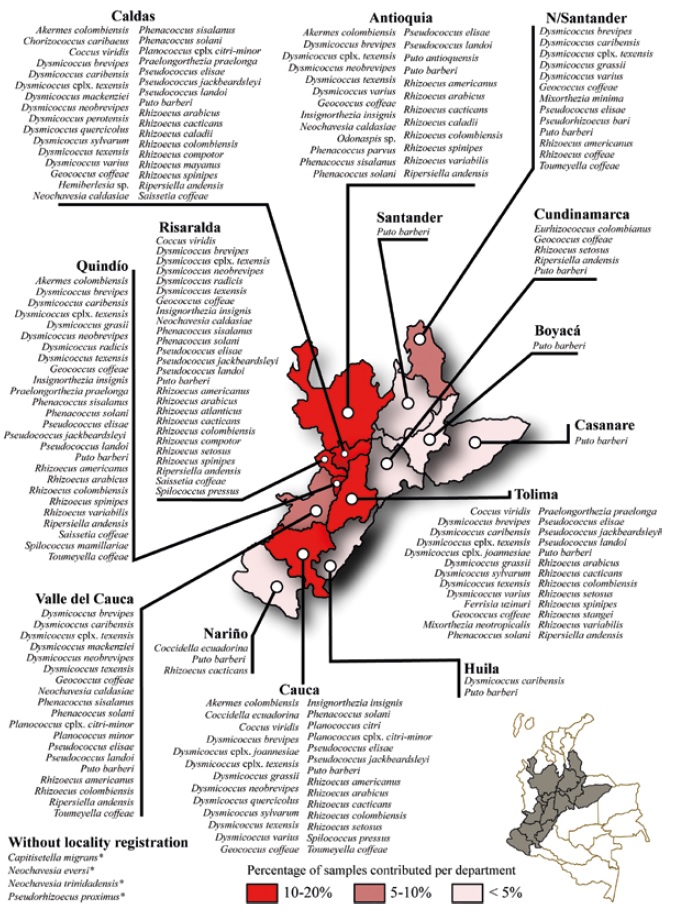
Source: Elaborated by the authors
Figure 1. Map of Colombia showing the distribution of scale insects associated with coffee roots and percentage of samples contributed by each of the 14 studied departments. Names with an asterisk (*) indicate that there is only a literature record.
Gil et al. (2015), Villegas et al. (2009) and Villegas- Garcia & Benavides-Machado (2011) mention that the most important species for Colombian coffee farming, due to the economic damage they cause, are D. brevipes, D. texensis/D. neobrevipes (in this study referenced as the Dysmicoccus complex texensis), G. coffeae, N. caldasiae, P. jackbeardsleyi and Pu. barberi. Of these species, those with the greatest geographic distribution are Pu. barberi (14 departments), G. coffeae (9 departments), D. brevipes and D. complex texensis (7 departments each).
Neochavesia caldasiae and Ps. jackbeardsleyi were collected only in three departments. Geococcus coffeae is the species most frequently found in the 541 samples analyzed, appearing in 37.9 % of the samples, followed by Pu. barberi (33.3 %) and D. complex texensis (24 %). Dysmicoccus brevipes (5.9 %), N. caldasiae (2.4 %) and P. jackbeardsleyi (0.7 %) show low occurrence.
In contrast, there is a high occurrence of species not mentioned in the literature as harmful to coffee, such as R. colombiensis (15.2 %), P. elisae (9.6 %) and R. arabicus (8.9 %); these three species, in terms of distribution, are found in six, seven and five departments respectively.
In this context, according to the distribution and frequency of occurrence, data provided in this study, the potentially most important species are Puto barberi, Geococcus coffeae, Dysmicoccus complex texensis, Rhizoecus colombiensis and Pseudococcus elisae.
This is supported by the altitudinal distribution for each species (figure 2). The five species mentioned above have the highest altitudinal range of the entire group of species found, covering about 1,200 m of elevation. Puto barberi has the largest distribution range (from 700 to 2.185 m), P. elisae occurs between 760 and 1,900 m.a.s.l., meanwhile D. complex texensis, G. coffeae and R. colombiensis occur between 1,000 and 2,200 m.a.s.l. Thus, three groups are then presented: the first is Puto barberi that is the species with the highest altitudinal adaptation capacity, allowing it to colonize coffee crops in warm, temperate and cold climates. The second is P. elisae that colonizes established crops in warm and temperate climates. In the third group, Dysmicoccus complex texensis, G. coffeae and R. colombiensis show the opposite behavior, as they colonize established crops in temperate and cold climates. It is worth noting that D. caribensis, although it is not a species with high recurrence in samples (0.7 %), has an altitudinal range as wide as P. elisae, and therefore, it must be a species that should be considered within the monitoring of scale insects in coffee roots.
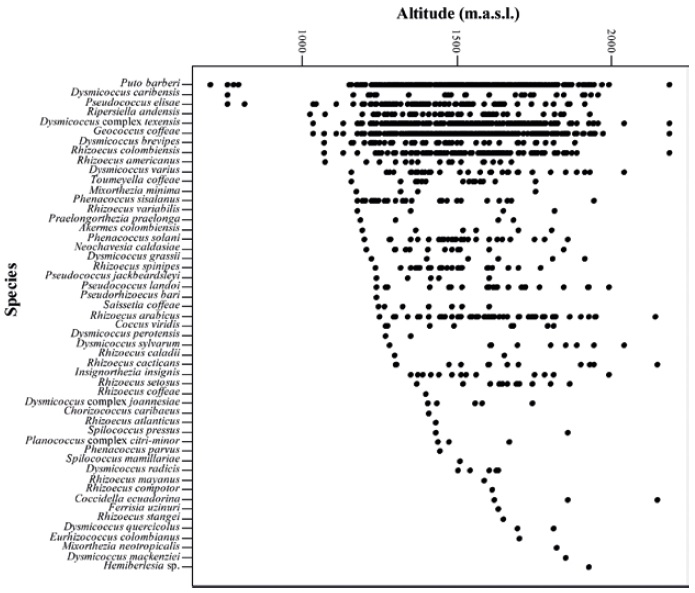
Source: Elaborated by the authors
Figure 2. Altimetry height interval of scale insect species associated with coffee roots in Colombia.
Another ecological criterion that is valuable in the agronomical aspect is the scale insect-ant relationship, given that it is the most common and effective non-anthropogenic form of dispersion of scale insects (Gullan, 1997; Johnson et al., 2001). The five scale insect species proposed here as a focus of attention and phytosanitary surveillance have multiple trophobiotic associations, i.e. Puto barberi is associated, at least, with 24 ant species; Geococcus coffeae with 23; Dysmicoccus complex texensis with 19; Rhizoecus colombiensis with 16, and Pseudococcus elisae with 12 (table 1, column 2 "Associated ants"). In this regard, it should be noted that D. brevipes is associated with at least 13 ant species.
Conclusions
This is the first study focused exclusively on the diversity of Coccomorpha associated with coffee roots in Colombia, in addition to considering its trophobiosis with ants. An advance in the taxonomic knowledge of scale insects is generated through new geographic and host records. The new information presented in this manuscript increases the records of species associated with coffee roots from 32 to 61 species, and the scale insects associated with coffee in Colombia in general (45 species).
It is important, however, to extend the sampling to biogeographical provinces where research has not been carried out, such as in the north and in the south of the country. Considering the diversity of agroecosystems in the regions where no samples were taken and of which there is no material conserved in entomological collections, the diversity of scale insect species that remains to be recorded associated with coffee may be much higher. In this sense, it is recommended to continue with the sample collection process throughout the country to deepen the knowledge of the diversity of scale insects and their associated ants.
It was observed that the group of scale insects associated with roots have been little studied and lack physical material (curated specimens conserved in entomological collections), that can be used in morphology, taxonomy and biodiversity studies. The contribution of cured material generated by this study aims at contributing with physical evidence of the fauna "megadiversity" that the country harbors.
The taxonomic results of this study have a future impact on the phytosanitary management of coffee crops. On one hand, Dysmicoccus complex texensis, Geococcus coffeae, Pseudococcus elisae, Puto barberi and Rhizoecus colombiensis are defined as the species with the greatest potential to become pests. Therefore, it is recommended to carry out studies in which it should be stated if these are real pests, and if they are, define the levels of damage and the corresponding economic thresholds.
In this same line and from a chemical control perspective, updating the list of species associated with coffee requires reevaluating the options that exist for the chemical management of these species.
Currently, there are only three molecules approved by ICA to control mealybugs (Pseudococcidae and Putoidae) on coffee: Thiamethoxam (neonicotinoid), Lambdacialotrine (pyrethroid) and Chlorpyrifos (organophosphate) (Instituto Colombiano Agropecuario [ICA], 2018). It is also recommended to begin with insecticide efficacy trials to expand the record of target species that include a larger part of the group of species and families that were listed in this study.
On the other hand, it has been verified that the occurrence and frequency of occurrence of the scale insect species is dynamic and changing, for which continuous sampling and taxonomic identification are necessary to make viable the integrated management plans of scale insects, and additionally, it is shown that within the population dynamics of scale insects, many more species than were expected just 10 years ago were involved.
In the current investigation no ants of the species Acropyga fuhrmanni and A. goeldii were found. Taking into account the extensive sampling carried out in the coffee growing areas of Colombia, it can be considered that the presence of these two species for coffee in Colombia is doubtful. On the other hand, the species A. exsanguis, A. smithii and A. close to guianensis show a wide distribution in the coffee growing areas of Colombia. Likewise, the species Linepithema angulatum (Emery, 1894), Brachymyrmex aphidicola Forel, 1909, B. patagonicus Mayr, 1868, B. pictus Mayr, 1887, Pheidole biconstricta Mayr, 1870 and P. radoszkowskii Mayr, 1884, are widely distributed in Colombia, with facultative associations with Hemiptera (Serna et al., in press).
The information obtained in the current study could be considered as a starting point for the agronomic management of ants and provides basic information for further investigations aimed at the insect scale-ant interaction.
Disclaimer
This study was financed by Colciencias (Programa Nacional de Ciencias Basicas [National Program on Basic Sciences]), code 110165843233, contract FP44842-004-2015), by the entomological museum UNAB (Facultad Ciencias Agrarias, Universidad Nacional de Colombia, sede Bogota) and by Federacion Nacional de Cafeteros. The authors declare that there are no conflicts of interest.
Acknowledgements
The authors wish to thank personally the Rural Extension Services of Federacion Nacional de Cafeteros and of Instituto Colombiano Agropecuario (ICA) for carrying out the study sampling. Moreover, many thanks to Andres David Meneses for the identification of the ants of the Brachymyrmex genus; also, to the curators John Alveiro Quiroz of Museo Entomologico Francisco Luis Gallego, Erika Vergara of Museo Entomologico UNAB and to the Entomological Collection Luis Maria Murillo CTNI; further, also to Juan Carlos from the Entomological Collection Marcial Benavides. The authors also want to thank Facultad de Ciencias Agrarias [Faculty of Agricultural Sciences] of Universidad Nacional de Colombia, Bogota campus, for facilitating the infrastructure and equipment to carry out this study. Finally, to the peer reviewers for their valuable input.
REFERENCES
Aono, M. (2009). Taxonomic study on Odonaspidini, with particular reference to sexual dimorphism in the second instar (Sternorrhyncha: Coccoidea: Diaspididae). Insecta Matsumurana. Series Entomology. New Series, 65, 1-92. [ Links ]
Balachowsky, A. S. (1957). Sur un nouveau genre aberrant de cochenille radicole myrmecophile nuisable au cafeier en Colombie. Revue de Pathologie Végétale et d’Entomologie Agricole de France, 36(1), 157-164. [ Links ]
Balachowsky, A. S. (1959). Nuevas cochinillas de Colombia I. Revista de la Academia Colombiana de Ciencias Exactas, Físicas y Naturales, 10(41), 337-361. [ Links ]
Beardsley, J. W. (1970). Three new species of Chavesia Balachowsky from Tropical America (Homoptera: Coccoidae). Proceedings of the Hawaiian Entomological Society, 20, 509-520. [ Links ]
Benavides-Gómez, M., & Cárdenas-Murillo, R. (1977). Hormigas de Amaga y de la Esperanza. Cenicafé Avances Técnicos, 69, 123-126. [ Links ]
Ben-Dov, Y. (1988). A taxonomic analysis of the armored scale tribe Odonaspidini of the World (Homoptera: Coccoide: Diaspididae). United States Department of Agriculture Technical Bulletin, 1723, 1-142. [ Links ]
Ben-Dov, Y. (1994). A systematic catalogue of the mealybugs of the world (Insecta, Homoptera, Coccoidea, Pseudococcidae and Putoidae): with data on geographical distribution, host plants, biology, and economic importance. Andover, Reino Unido: Intercept Limited. [ Links ]
Ben-Dov, Y. (2005). The solanum mealybug, Phenacoccus solani Ferris (Hemiptera: Coccoidea: Pseudococcidae), extends its distribution range in the Mediterranean Basin. Phytoparasitica, 33(1), 15-16. doi:10.1007/BF02980920. [ Links ]
Ben-Dov, Y., & Hodgson, C. J. (1997). Soft scale insects their biology, natural enemies and control. Volumen 7A. Amsterdam, Paises Bajos: Elsevier Science Publishers. [ Links ]
Bustillo, A. E. (2008). Los insectos y su manejo en la caficultura colombiana. Chinchina, Colombia: Centro Nacional de Investigaciones de Café (Cenicafe). [ Links ]
Caballero, A., Ramos-Portilla, A. A., Gil, Z. N., & Benavides, P. (2018). Insectos escama (Hemiptera: Coccomorpha) en raíces de café de Norte de Santander y Valle del Cauca, Colombia y descripcion de una nueva especie. Revista Colombiana de Entomología, 44(1), 120-128. doi:10.25100/socolen.v44i1.6757. [ Links ]
Chatzidimitriou, E., Simonato, M., Watson, G. W., Martinez- Sanudo, I., Tanaka, H., Zhao, J., & Pellizzari, G. (2016). Are Phenacoccus solani Ferris and P. defectus Ferris (Hemiptera: Pseudococcidae) distinct species? Zootaxa, 4093(4), 539- 551. doi:10.11646/zootaxa.4093.4.5. [ Links ]
Cox, J. M. (1978). Revision of the Rhizoecus species (Homoptera: Pseudococcidae) known from New Zealand. New Zealand Journal of Zoology, 5, 623-638. [ Links ]
De Lotto, G. (1965). On some Coccidae (Homoptera), chiefly from Africa. Bulletin of the British Museum (Natural History) Entomology, 16(4), 175-239. [ Links ]
Departamento Administrativo Nacional de Estadística (DANE). (2016). 3er Censo Nacional Agropecuario. Hay campo para todos. Tomo 2. Recuperado de https://www.dane.gov.co/files/images/foros/foro-de-entrega-de-resultadosy-cierre-3-censo-nacional-agropecuario/CNATomo2-Resultados.pdf. [ Links ]
Federación Nacional de Cafeteros. (1932). Manual del Cafetero Colombiano. Bogotá, Colombia: Litografia Colombia. [ Links ]
Fernández, F. (2003). Introducción a las hormigas de la región neotropical. Bogotá, Colombia: Instituto de Recursos Biologicos Alexander von Humboldt. [ Links ]
Figueroa, A. (1946). Catalogo inicial de las cochinillas del Valle del Cauca (Homoptera-Coccoidea). Revista Facultad Nacional de Agronomía, 6, 196-220. [ Links ]
Food and Agricuture Organization of the United Nations (FAO). (2015). FAO Statistical Pocketbook Coffee 2015. Recuperado de http://www.fao.org/3/a-i4985e.pdf. [ Links ]
Gallego, F. L., & Vélez, R. (1992). Lista de insectos que afectan los principales cultivos, plantas forestales, animales domésticos y al hombre en Colombia. Medellín, Colombia: Universidad Nacional de Colombia. [ Links ]
García-Morales, M., Denno, B., Miller, D. R., Miller, G. L., Ben-Dov, Y., & Hardy, N. B. (2016). ScaleNet: A literaturebased model of scale insect biology and systematics. Database, 2016. doi:10.1093/database/bav118. [ Links ]
Gavrilov, I. A., & Kuznetsova, V. G. (2007). On some terms used in the cytogenetics and reproductive biology of scale insects (Homoptera: Coccinea). Comparative Cytogenetics, 1(2), 169-174. [ Links ]
Gil, Z. N., & Benavides, P. (2017). Descripcion de la escama de la raiz del café Toumeyella coffeae Kondo (Hemiptera: Coccidae). Revista Cenicafé, 68(1), 7. [ Links ]
Gil, Z. N., Benavides, P., & Villegas, C. (2015). Manejo integrado de las cochinillas de las raíces del café. Cenicafé Avances Técnicos, 459, 1-8. [ Links ]
Gill, R. J. (1988). The scale insects of California Part 1: The soft scales (Homoptera: Coccoidea: Coccidae). Sacramento, EE. UU.: California Department of Food and Agriculure. [ Links ]
Gill, R. J., Nakahara, S., & Williams, M. L. (1977). A review of the genus Coccus Linnaeus in America North of Panama (Homoptera: Coccoidea: Coccidae). Occasional Papers of the Bureau of Entomology, 24, 1-47. [ Links ]
Gimpel, W. F., & Miller, D. R. (1996). Systematic analysis of the mealybugs in the Pseudococcus maritimus complex (Homoptera: Pseudococcidae). Contributions on Entomology, International, 2(1), 1-163. [ Links ]
Granara de Willink, M. C. (2009). Dysmicoccus de la Region Neotropical (Hemiptera: Pseudococcidae). Revista de la Sociedad Entomológica Argentina, 68(1-2), 11-95. [ Links ]
Granara de Willink, M. C., & Szumik, C. (2007). Phenacoccinae de Centro y Sudamerica (Hemiptera: Coccoidea: Pseudococcidae): Sistematica y Filogenia. Revista de la Sociedad Entomológica Argentina, 66(1-2), 29-129. [ Links ]
Gullan, P. J. (1997). Relationships with ants. En Y. Ben-Dov & C. J. Hodgson (Eds.), Soft Scale Insects - Their Biology, Natural Enemies and Control (Vol. 7, pp. 351-373). Amsterdam, Paises Bajos: Elsevier Science. doi:10.1016/S1572-4379(97)80065-6. [ Links ]
Gullan, P. J., & Cranston, P. S. (2005). The insects: An outline of entomology (3rd ed.). Oxford, Reino Unido: Blackwell Publishing. doi:10.1017/CBO9781107415324.004. [ Links ]
Gullan, P. J., & Martin, J. (2003). Sternorrhyncha ( Jumping Plant Lice, Whiteflies, Aphids, and Scale Insects). En V. H. Resh & R. T. Carde (Eds.), Encyclopedia of Insects (pp. 1079-1089). Cambridge, EE. UU.: Academic Press. [ Links ]
Hambleton, E. J. (1946). Studies of hypogeic mealybugs. Revista de Entomología. Rio de Janeiro, 17(1), 1-77. [ Links ]
Hambleton, E. J. (1976). A revisión of the New World mealybugs of the genus Rhizoecus (Homoptera: Pseudococcidae). United States Department of Agriculture Technical Bulletin, 1522, 1-88. [ Links ]
Hambleton, E. J. (1977). A review of Pseudorhizoecus Green, with a description of a related new genus (Homoptera: Pseudococcidae). Journal of Washington Academy of Sciences, 67(1), 38-41. [ Links ]
Instituto Colombiano Agropecuario (ICA). (2018). Plaguicidas Químicos. Recuperado de https://www.ica.gov.co/Areas/Agricola/Servicios/Regulacion-y-Control-de-Plaguicidas-Quimicos.aspx [ Links ]
Jakubski, A. W. (1965). A critical revisión of the families Margarodidae and Termitococcidae (Hemiptera, Coccoidea). Londres, Reino Unido: Trustees of the British Museum (Natural History). [ Links ]
Jiménez, E., Fernández, F., Arias, T., & Lozano-Zambrano, F. (2007). Sistemática, biogeografía y conservación de las hormigas cazadoras de Colombia. Bogotá, Colombia: Instituto de Investigación de Recursos Biologicos Alexander von Humboldt. [ Links ]
Johnson, C., Agosti, D., Delabie, J. H., Dumpert, K., Williams, D. J., Tschirnhaus, M. V., & Maschwitz, U. (2001). Acropyga and Azteca ants (Hymenoptera: Formicidae) with scale insects (Sternorrhyncha: Coccoidea): 20 million years of intimate symbiosis. American Museum Novitates, 3335(1), 1-18. doi:10.1206/0003-0082(2001)335< 0001:AAAAHF>2.0.CO;2. [ Links ]
Kondo, T. (2001). Las cochinillas de Colombia (Hemiptera: Coccoidea). Biota Colombiana, 2(1), 31-48. [ Links ]
Kondo, T. (2013). A new species of Toumeyella Cockerell (Hemiptera: Coccoidea: Coccidae) on coffee roots, Coffea arabica L. (Rubiaceae), from Colombia and Venezuela. Corpoica Ciencia y Tecnología Agropecuaria, 14(1), 39-51. [ Links ]
Kondo, T., & Gullan, P. J. (2010). The Coccidae (Hemiptera: Coccoidea) of Chile, with descriptions of three new species and transfer of Lecanium resinatum Kieffer & Herbst to the Kerriidae. Zootaxa, 2560(1), 1-15. [ Links ]
Kondo, T., Ramos, A. A., & Vergara, E. (2008). Updated list of mealybugs and putoids from Colombia (Hemiptera: Pseudococcidae and Putoidae). Boletín del Museo de Entomología de la Universidad del Valle, 9(1), 29-53. [ Links ]
Kondo, T., Rodríguez, J. M., Diaz, M. F., Dix, O. J., & Palacio, E. (2018). Description of two new species of Cryptinglisia Cockerell (Hemiptera: Coccomorpha: Coccidae) associated with rosemary, Rosmarinus officinalis L. (Lamiaceae) in Colombia. Zootaxa, 4420(3), 379. doi:10.11646/zootaxa.4420.3.4. [ Links ]
Kondo, T, & Williams, M. L. (2004). A new species of myrmecophilous soft scale insect from Colombia in the genus Akermes Cockerell (Hemiptera: Coccoidea: Coccidae). Revista Colombiana de Entomología, 30(2), 137-141. [ Links ]
Kondo, T., & Gómez, C. (2008). La perla de tierra, Eurhizococcus colombianus, una nueva plaga de la vid, Vitis labrusca L. en el Valle del Cauca. Novedades Técnicas Corpoica, 9(10), 34-40. [ Links ]
Kosztarab, M. (1996). Scale Insects of Northeastern North America: Identification, Biology and Distribution (3a ed.). Martinsville, EE. UU.: Virginia Museum of Natural History. [ Links ]
Kosztarab, M., & Kozar, F. (1988). Scale Insects of Central Europe. Budapest, Hungria: Dr. W. Junk Pulishers. [ Links ]
Kozar, F., & Konczne-Benedicty, Z. (2007). Rhizoecinae of the World. Budapest, Hungria: Plant Protection Institute, Hungrian Academy of Science. [ Links ]
LaPolla, J. (2004). Acropyga (Hymenoptera: Formicidae) of the world. Contributions of the American Entomological Institute, 33(3), 1-130. [ Links ]
LaPolla, J., Brady, S., & Shattuck, S. (2010). Phylogeny and taxonomy of the Prenolepis genus-group of ants (Hymenoptera: Formicidae). Systematic Entomology, 35(1), 118-131. doi:10.1111/j.1365-3113.2009.00492.x. [ Links ]
LaPolla, J., & Fisher, B. (2014). Then there were five: a reexamination of the ant genus Paratrechina (Hymenoptera: Formicidae). ZooKeys, 422, 35-48. doi:10.3897/zookeys.422.7779. [ Links ]
Le Pelley, R. H. (1973). Coffee insects. Annual Review of Entomology, 18, 121-142. doi:10.1146/annurev.en.18.010173.001005. [ Links ]
Longino, J. (2009). Additions to the taxonomy of New World Pheidole (Hymenoptera: Formicidae). Zootaxa, 2181, 1-90. [ Links ]
Longino, J., & Fernández, F. (2007). Taxonomic review of the genus Wasmannia. En R. Snelling, B. Fisher, & P. Ward (Eds.), Advances in ant systematics (Hymenoptera: Formicidae): homage to E. O. Wilson – 50 years of contributions (pp. 271-289). Gainesville, EE. UU.: American Entomological Institute. [ Links ]
McKenzie, H. L. (1967). Mealybugs of California with taxonomy, biology and control of North American species (Homoptera: Coccoidea: Pseudococcidae). Berkeley, EE. UU.: University of California Press. [ Links ]
Miller, D. R., & McKenzie, H. L. (1971). Sixth taxonomic study of North American mealybugs, with additional species from South America (Homoptera: Coccoidea: Pseudococcidae). Hilgardia, 40(17), 565-602. doi:10.3733/hilg.v40n17p565. [ Links ]
Miller, D. R., & McKenzie, H. L. (1973). Seventh taxonomic study of North American mealybugs (Homoptera: Coccoidea: Pseudococcidae). Hilgardia, 41(17), 489-542. doi:10.3733/hilg.v41n17p489. [ Links ]
Murillo, L. M. (1931). Los parasitos del café en el departamento de Antioquia. Revista Cafetera de Colombia, 3(1), 943-949. [ Links ]
Pacheco, J., & Mackay, W. (2013). The systematics and biology of the new world thief ants of the genus Solenopsis (Hymenoptera: Formicidae). Lewiston, EE. UU.: Edwin Mellen Press. [ Links ]
Posada, L. (1989). Lista de insectos dañinos y otras plagas en Colombia. Boletín Técnico 43 (4a ed.). Bogotá, Colombia: Instituto Colombiano Agropecuario (ICA). [ Links ]
Ramos, A. A., & Serna, F. J. (2004). Coccoidea de Colombia, con enfasis en las cochinillas harinosas (Hemiptera: Pseudococcidae). Revista de la Facultad Nacional de Agronomía de Medellín, 57(2), 2383–2412. [ Links ]
Ramos-Portilla, A. A., & Caballero, A. (2016). Rhizoecus colombiensis Ramos & Caballero, a new species of hypogeal mealybug (Hemiptera: Coccomorpha: Rhizoecidae) and a key to the species of Rhizoecus from Colombia. Zootaxa, 4092(1), 55-68. doi:10.11646/zootaxa.4092.1.3. [ Links ]
Sarnat, E., Fischer, G., Guenard, B., & Economo, E. (2015). Introduced Pheidole of the world: taxonomy, biology and distribution. ZooKeys, 543, 1-109. doi:10.3897/zookeys.543.6050. [ Links ]
Schneider, S. A., & Lapolla, J. S. (2011). Systematics of the mealybug tribe Xenococcini (Hemiptera: Coccoidea: Pseudococcidae), with a discussion of trophobiotic associations with Acropyga Roger ants. Systematic Entomology, 36(1), 57-82. doi:10.1111/j.1365-3113.2010.00546.x. [ Links ]
Serna, F., Mera-Rodríguez, D., Ramirez, K., & Gaigl, A. (en prensa). Capitulo 34. Hormigas de mayor impacto en la agricultura colombiana. En F. Fernández, T. Delsinne, & R. Guerrero (Eds.), Hormigas de Colombia. Bogotá, Colombia: Universidad Nacional de Colombia. [ Links ]
Sirisena, U. G., Watson, G. W., Hemachandra, K. S., & Wijayagunasekara, H. N. (2013). A modified technique for the preparation of specimens of Sternorryncha for taxonomic studies. Tropical Agricultural Research, 24(2), 139-149. [ Links ]
Villegas, C., Benavides, P., Zabala, G., & Ramos, A. A. (2009). Cochinillas harinosas asociadas a las raíces del café: descripcion y biología. Cenicafé Avances Técnicos, 386, 8. [ Links ]
Villegas-García, C., & Benavides-Machado, P. (2011). Identificacion de cochinillas harinosas en las raíces de café en departamentos cafeteros de Colombia. Revista Cenicafé, 62(1), 48-55. [ Links ]
Von Ellenrieder, N., & Watson, G. (2016). A new mealybug in the genus Pseudococcus Westwood (Hemiptera: Coccomorpha: Pseudococcidae) from North America, with a key to species of Pseudococcus from the New World. Zootaxa, 4105(1), 65-87. doi:10.11646/zootaxa.4105.1.3. [ Links ]
Waller, J. M., Bigger, M., & Hillocks, R. J. (2007). Coffee pests, diseases and their management. Oxford, Reino Unido: CAB International. [ Links ]
Wild, A. (2007). Taxonomic revisión of the ant genus Linepithema (Hymenoptera: Formicidae) (Vol. 126). Berkeley, EE. UU.: University of California Press. [ Links ]
Williams, D. J. (1998). Mealybugs of the general Eumyrmococcus Silvestri and Xenococcus Silvestri associated with the ant genus Acropyga Roger and a review of the subfamily Rhizoecinae (Hemiptera, Coccidae, Pseudococcidae). Bulletin of the British Museum (Natural History), 67(1), 1-152. [ Links ]
Williams, D. J. (2004a). A synopsis of the subterranean mealybug genus Neochavesia Williams and Granara de Willink (Hemiptera: Pseudococcidae: Rhizoecinae). Journal of Natural History, 38(22), 2883-2899. doi:10.1080/00222930310001657856. [ Links ]
Williams, D. J. (2004b). Mealybugs of southern Asia. Kuala Lumpur, Malasia: Southdene Sdn. Bhd. [ Links ]
Williams, D. J., & Granara de Willink, M. C. (1992). Mealybugs of Central and South America. Londres, Reino Unido: CAB International. [ Links ]
Williams, D. J., & Hodgson, C. J. (2014). The case for using the infraorder Coccomorpha above the superfamily Coccoidea for the scale insects (Hemiptera: Sternorrhyncha). Zootaxa, 3869(3), 348–350. doi:10.11646/zootaxa.3869.3.9. [ Links ]
Williams, D. J., & Watson, G. W. (1988). The Scale Insects of the Tropical South Pacific Region. Pt. 1. The Armoured Scales (Diaspididae). Wallingford, Reino Unido: CAB International. [ Links ]
Williams, M. L., & Kosztarab, M. (1972). Morphology and systematics of the Coccidae of Virginia with notes on their biology (Homoptera: Coccoidea). Blacksburg, EE. UU.: Virginia Polytechnic Institute and State University. [ Links ]
Wilson, E. (2003). Pheidole in the new world: A dominant, hyperdiverse ant genus. Cambridge, EE. UU.: Harvard University Press. [ Links ]
Received: June 09, 2018; Accepted: November 29, 2018











 texto em
texto em 


